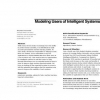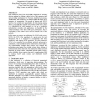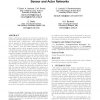717 search results - page 139 / 144 » Autonomous mobility skeletons |
CHI
2011
ACM
12 years 11 months ago
2011
ACM
While many devices today increasingly have the ability to predict human activities, it is still difficult to build accurate personalized machine learning models. As users today wi...
SIGMOD
2001
ACM
14 years 7 months ago
2001
ACM
Data warehouses have been successfully employed for assisting decision making by offering a global view of the enterprise data and providing mechanisms for On-Line Analytical proc...
MOBIHOC
2008
ACM
14 years 7 months ago
2008
ACM
Sensor networks are expected to evolve into long-lived, autonomous networked systems whose main mission is to provide in-situ users ? called actors ? with real-time information in...
ICC
2009
IEEE
14 years 2 months ago
2009
IEEE
— In this paper, we propose a game theoretical approach to tackle the problem of the distributed formation of the uplink tree structure among the relay stations (RSs) and their s...
LOCA
2009
Springer
14 years 2 months ago
2009
Springer
With proliferation of ubiquitous computing, digital access is facing an increasing risk since unauthorized client located at any place may intrude a local server. Location Based Ac...




